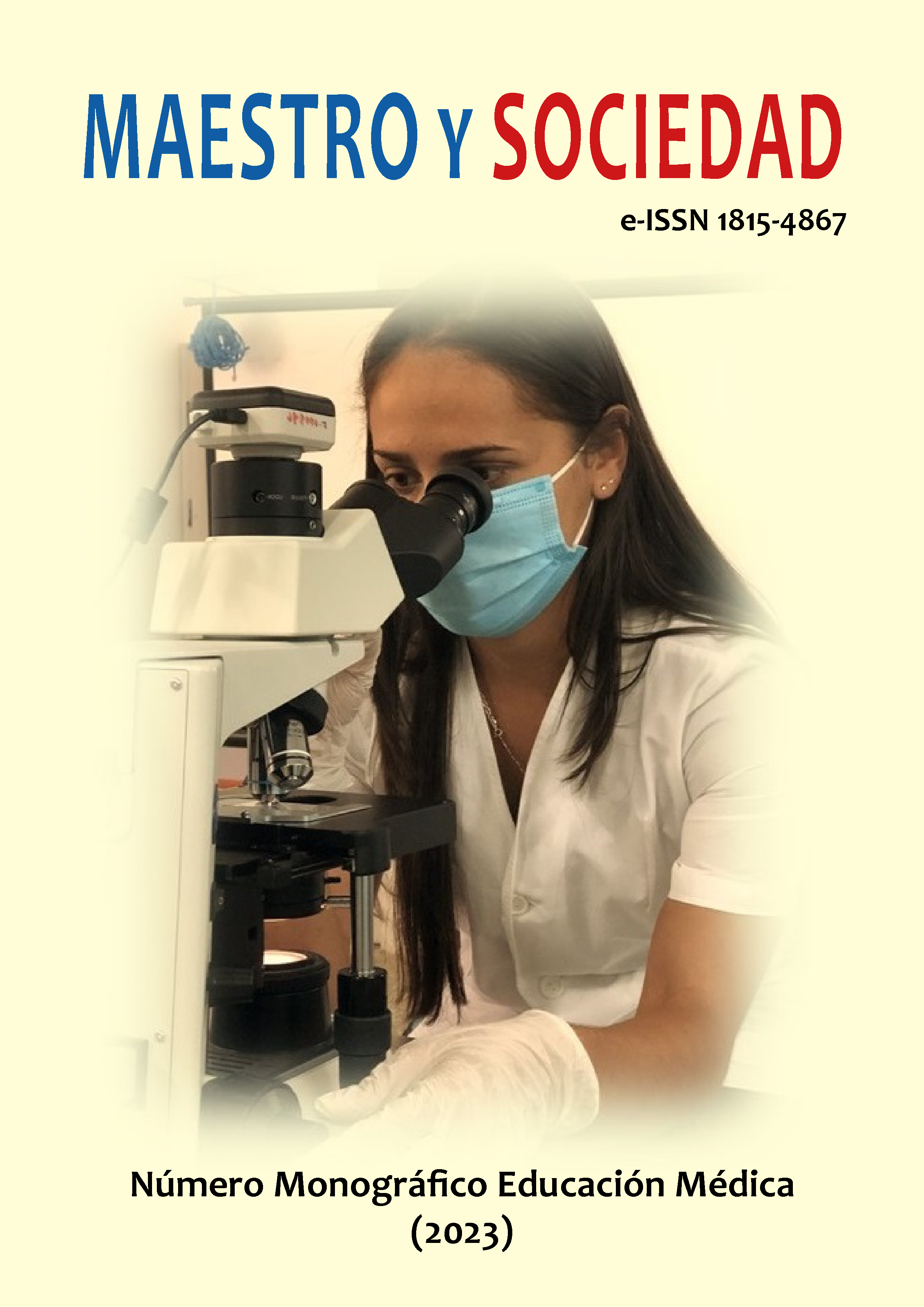Caracterización fisiopatológica de pacientes con infarto agudo de miocardio con elevación del segmento ST
Palabras clave:
Infarto agudo de miocardio, cardiopatía isquémica, elevación del segmento ST, características fisiopatológicasResumen
Introducción: El infarto agudo de miocardio (IAM), representa la manifestación más significativa de la cardiopatía
isquémica, que se presenta cuando se produce una oclusión coronaria aguda provocando necrosis del miocardio a
consecuencia de una isquemia grave. Materiales y Métodos: Se realizó un estudio descriptivo transversal retrospectivo
en 765 pacientes con infarto agudo de miocardio con elevación del segmento ST en el periodo de 2018 a 2022 con el
objetivo de describir las características fisiopatológicas del Infarto Agudo de Miocardio en pacientes con elevación del
segmento ST. Los datos fueron obtenidos de las historias clínicas. Se estudiaron las variables: edad, sexo, factores de
riesgo coronario modificables, evaluación del estado nutricional, topografía, complicaciones, criterios diagnósticos y
defunción. Se empleó para el procesamiento de la información la estadística descriptiva (frecuencia absoluta y relativa).
Resultados: La población mayor de 77 años masculina fue más propensa a fallecer por enfermedades cardiovasculares.
El factor de riesgo coronario de mayor relevancia encontrado fue la hipertensión arterial. La localización más frecuente
fue en la cara inferior, las complicaciones hemodinámicas prevalecieron en la población estudiada y los criterios clínicos
y electrocardiográficos fueron los más empleados para obtener el diagnóstico de los pacientes. Discusión: Investigadores
cubanos como Molina et al. realizaron varios aportes, ya que hallaron que los pacientes con cifras iguales o superiores a
140 mmHg de presión arterial sistólica presentaron un riesgo tres veces mayor de sufrir una enfermedad cardiovascular.
Está demostrado que el 50,0 % de los hipertensos sufre dolor precordial y que la posibilidad de un accidente coronario
mayor es 3 veces superior en estos pacientes. Conclusiones: Los hombres son los más afectados por el infarto agudo
de miocardio, así como la hipertensión arterial junto con el tabaquismo constituyeron los factores de riesgo coronarios
de mayor relevancia, éste último desencadena la liberación de las catecolaminas ocasionando daño en el endotelio,
aumenta el tono coronario con espasmo y produce alteraciones de la coagulación.
Citas
Colectivo de autores. (2020). Guía ESC/EAS 2019 sobre el tratamiento de las dislipemias. European Heart Journal. 41, 111-188. https://academic.oup.com/eurheartj/article-lookup/doi/10.1093/eurheartj/ehz455#supplementary-data
Cordero A, et al. (2012). Mortalidad a largo plazo y reingreso hospitalario tras infarto agudo de miocardio, un estudio de seguimiento de ocho años. Rev Esp Cardiol. 65(5), 414-420. https://www.revespcardiol.org/en-mortalidadlargo-plazo-reingreso-hospitalario-articulo-S0300893211008025
Fernández-Ortiz. A. (2018). ¿Qué es el infarto agudo de miocardio? https://www.fbbva.es/microsites/salud_cardio/fbbva_libroCorazon_ficha_28.html.
Franco, M. R., Sainz, B., Ramos, B. y Frías, J. A. (2015). Caracterización de pacientes con infarto agudo de miocardio con elevación del segmento ST. Rev Cub Cardiol Cir Cardiovasc. 21(1), 16-23. https://www.medigraphic.com/pdfs/cubcar/ccc-2015/ccc151d.pdf
Kristian K, Alpert JS, Jaffe AF, Chaitman BR, Bax JJ, Morrow DA, White HD. (2019). Consenso ESC 2018 sobre la cuarta definición universal del infarto de miocardio. Rev Esp Cardiol. 2019; 72 (1):72. e1-e27.
Martínez A, Sainz BA, Ramos B, Pacheco E, Zorio BY, Castañeda G. (2017). Infarto agudo con elevación del ST en el servicio de urgencias del Instituto de Cardiología. Rev Cuban Cardiol, 23(1). http://revcardiologia.sld.cu/index.php/revcardiologia/article/view/677/pdf_76
Mirvis DM, Goldberger AL. (2019). Electrocardiography. En: Braunwald‘s Heart Disease. 11 ed. Elsevier Saunders. 135.
Noya, M. E. y Moya, N. L. Roca Goderich. (2017). Temas de Medicina Interna I. (5.ª ed.). Editorial Ciencias Médicas.
Ortega Torres YY, Armas Rojas NB, Dueñas Herrera A, De la Noval R, Acosta Rodríguez M. (2015). Prevención primaria de la cardiopatía isquémica. Aspectos de interés. Rev Cub. de Cardiol; 21(1). http://www.revcardiologia.sld.cu/index.php/revcardiologia/article/view/566
Sánchez VM, Bosch C, Sánchez TM y González JC. (2014). Morbilidad y mortalidad por Infarto Agudo de Miocardio. MEDISAN, 18(4), 516-522. http://scielo.sld.cu/scielo.php?script=sci_arttext&pid=S1029-30192014000400008&lng=es
Descargas
Publicado
Cómo citar
Número
Sección
Licencia
Derechos de autor 2023 Annie Gil Landave, Odalis Querts Méndez, Maidilis Beltrán Moret, Yusnay Robert Ramos

Esta obra está bajo una licencia internacional Creative Commons Atribución-NoComercial-SinDerivadas 4.0.
Esta revista proporciona un acceso abierto inmediato a su contenido, basado en el principio de que ofrecer al público un acceso libre a las investigaciones ayuda a un mayor intercambio global de conocimiento. Cada autor es responsable del contenido de cada uno de sus artículos. Los artículos pueden ser inéditos o estar disponibles previamente en servidores de preprints reconocidos por la revista. Sin embargo, no se permite la duplicación de la publicación o traducción de un artículo ya publicado en otra revista o como capítulo de un libro.
This journal provides immediate open access to its content, based on the principle that providing the public with free access to research supports a greater global exchange of knowledge. Each author is responsible for the content of each of their articles. Articles may be previously unpublished or available on preprint servers recognized by the journal. However, duplication of publication or translation of an article already published in another journal or as a book chapter is not permitted.
Esta revista oferece acesso aberto imediato ao seu conteúdo, com base no princípio de que oferecer ao público acesso gratuito à pesquisa contribui para um maior intercâmbio global de conhecimento. Cada autor é responsável pelo conteúdo de cada um de seus artigos. Os artigos poderão ser inéditos ou estar previamente disponíveis em servidores de preprints reconhecidos pela revista. No entanto, não é permitida a duplicação de publicação ou tradução de artigo já publicado em outro periódico ou como capítulo de livro.



























 Universidad de Oriente
Universidad de Oriente 